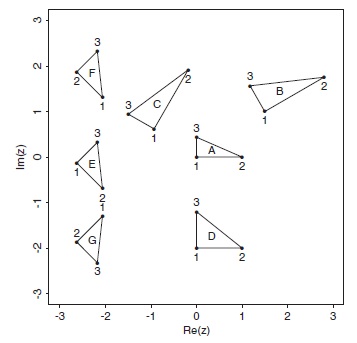Exercises
-
Which of the triangles in Figure E.1 have the same size and the same shape (assume by ‘shape’ we mean labelled shape)?

Figure E.1 Some triangles.
Which triangles have the same shape but different sizes?
Which triangles have different shapes but the same ‘reflection shape’ (i.e. a translation, rotation, scale and a reflection will match them exactly)?
-
Rank the triangles in Figure E.1 in order of increasing centroid size. Repeat the rankings using baseline size (with baseline 1, 2) and square root of area.
-
Informally rank the triangles in Figure E.1 in order of ‘closeness’ to the anti-clockwise labelled equilateral triangle.
-
In a forensic study photographs of the front view of the faces of alleged criminals are taken. Some landmarks are to be located on the face. For each of the following landmarks decide whether it is a Bookstein’s Type I, II or III landmark. Also, state whether they are anatomical, mathematical or pseudo-landmarks.
- Pupil of the eye
- Tip of the nose
- Corners of the mouth
- Point on the cheek halfway between the pupil of the eye and corner of the mouth.
- Centre of the forehead.
- Lowest point on the chin.
Which landmarks are easy to locate and which are difficult?
-
Prove the result that

-
Consider the Helmert submatrix H. Write down ...
Get Statistical Shape Analysis, 2nd Edition now with the O’Reilly learning platform.
O’Reilly members experience books, live events, courses curated by job role, and more from O’Reilly and nearly 200 top publishers.

